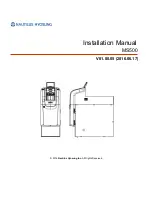
212
User-defined Errors
Section 9-4
9-4
User-defined Errors
There are two instructions that the user can use to define errors or messages.
These instructions can be used to generate warnings (non-fatal errors where
the ERC flashes) or errors (fatal errors where the ERC lights).
FAILURE ALARM –
FAL(06)
FAL(06) is an instruction that causes a non-fatal error. The following will occur
when an FAL(06) instruction is executed:
1,2,3...
1.
The ERC indicator on the Customizable Counter Unit will flash. Operation
will continue.
2.
The instruction’s 2-digit BCD FAL number (01 to 99) will be written to
SR 23500 to SR 23507.
3.
The FAL number will be recorded in the error log area in the Customizable
Counter Unit. The time of occurrence will also be recorded.
The FAL numbers can be set arbitrarily to indicate particular conditions. The
same number cannot be used as both an FAL number and an FALS number.
To clear an FAL error, correct the cause of the error, execute FAL 00, and then
clear the error using the Programming Console.
SEVERE FAILURE ALARM
– FALS(07)
FALS(07) is an instruction that causes a fatal error. The following will occur
when an FALS(07) instruction is executed:
1,2,3...
1.
Program execution will be stopped.
2.
The ERC indicator on the Customizable Counter Unit will light.
3.
The instruction’s 2-digit BCD FALS number (01 to 99) will be written to
SR 23500 to SR 23507.
4.
The FALS number will be recorded in the error log area in the Customiz-
able Counter Unit. The time of occurrence will also be recorded.
The FALS numbers can be set arbitrarily to indicate particular conditions. The
same number cannot be used as both an FAL number and an FALS number.
To clear an FALS error, switch the PLC to PROGRAM Mode, correct the
cause of the error, and then clear the error using the Programming Console.
Summary of Contents for CS1W-HCA12-V1
Page 2: ......
Page 6: ...vi...
Page 20: ...xx Conformance to EC Directives 7...
Page 38: ...18 Models and System Configurations Section 1 2...
Page 78: ...58 Fail safe Circuits Section 3 5...
Page 138: ...118 AR Area Section 6 4...
Page 204: ...184 Improved Instructions Section 7 14...
Page 222: ...202 Cycle Time Section 8 3...
Page 240: ...220 Troubleshooting Flowcharts Section 9 5...
Page 244: ...224 Precautions when Using the CX Programmer Appendix A...
Page 252: ......
Page 253: ......
















































